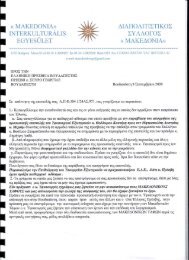Görög Örökség Ελληνική Κληρονομιά - H-ellin.com
Görög Örökség Ελληνική Κληρονομιά - H-ellin.com
Görög Örökség Ελληνική Κληρονομιά - H-ellin.com
Create successful ePaper yourself
Turn your PDF publications into a flip-book with our unique Google optimized e-Paper software.
33 houses. During the 19' century there was considerable decrease due to natural adjustment. In 1896 only 45<br />
orthodox believers were living in Miskolc.<br />
At the beginning the greek <strong>com</strong>munity in Miskolc included monks (probably they were wandering monks who<br />
were offered hospitality for a while). " The wandering monks might have collected donations for their<br />
monasteries and at the same time their presence was essential in spreading manuscripts and publications<br />
written in the greek language..". Since 1756 they had permanent priests, some times, even two simultaneously<br />
such as in 1777. They used two names "parokus" and "Kaplan" (the latter not meaning the assistant priest but<br />
meaning the "priest of the chapel". In latin, the word chapel is capella, so the word "Kaplan" means the "one<br />
who serves in the chapel").<br />
In the second half of the 19' century, the Greek priest of Miskolc was Emilian Margo ( brother of the famous<br />
doctor-professor Tivadar Margo). The last priest of Greek origin in the 20' century was Konstantin Popovics ,<br />
who for almost 40 years ( until his death at the beginning of the 70s) was in charge of the greek parish in<br />
Miskolc and obtain great honor in safeguarding the treasures of the greek <strong>com</strong>munity. He played a great role<br />
in replenishing the orthodox belief in Miskolc after the crisis at the beginning of the 20' century. During his<br />
service, at the beginning of 1950 the <strong>com</strong>munity was integrated in the Hungarian orthodox church. At the<br />
beginning of the 19' century, the Greeks in Miskolc were calling themselves "Macedonian-Vlachoi of the old<br />
belief". During the 18' century the greek <strong>com</strong>munity exceeded the frames of the chapel dedicated to Agios<br />
Naoum. Already in 1777 they asked the metropolitan bishop of Karlovac to give them permission in order to<br />
build a temple( the by the Greeks established <strong>com</strong>munity of Miskolc belonged directly to Karlovac). The<br />
foundation stone of the temple, which was designed by Johann Michart, was placed in 1785. It was blessed by<br />
the greek bishop of Buda, Dionusziosz Popovics in the name of the Holy Trinity. The shrine, the decoration<br />
and the Holly Grave were created by Miklós Jankovics, which is proven by the latin-greek inscription on top<br />
of the royal gate which contains the name of the wood sculptor and on the sides of the text the years 1791 and<br />
1793 appear in the shape of a ribbon. The greek text consists of the words that describe the act of crossing<br />
oneself. The drawings in the shrine and the paintings are works of the painter Anton Kulchmeister.<br />
In Miskolc, the treasures of the temple and of the greek <strong>com</strong>munity are presented in more exhibitions. In the<br />
building of the parish ( once of a greek school) opened a Hungarian Orthodox Museum. The "Greek yard"<br />
stands almost unspoiled and they also maintained some of the houses of the Greek traders in Széchenyi street.<br />
In the northern part of the "Greek yard" exists the building of the old hospital.<br />
Szentendre<br />
The Temple Blagovesztenszka with its Slavic name which is in Fo square in Szentendre, is more popularly<br />
known as "Grecska"( the name as a nickname means "young Greek"). ( The Slavic name is Annunciation of<br />
the Mother of God-Evagelismos Theotokou-a celebration of the 25' of March.). Some people claim that the<br />
name "Grecska" derives from the greek inscription in the tombstone which is in the side gate. As we continued<br />
the search, however, we discovered an interesting clue. In one of the protocols in 1697 we can see the<br />
<strong>com</strong>plete diagram of the coverage of Szentendre in which we find the "Temple of the greeks" and then a few<br />
lines further, the "Temple of the Serbians'. Analyzing the text of the protocol we conclude that the Temple of<br />
the Serbians was probably in the place of the current memorial cross of Tsar Lazaros and the one of the Greeks<br />
was in "the street that leads to the Danube", in other words in the same place where the existing above<br />
mentioned temple is nowadays.<br />
Both the Greeks and the Serbians had their own temple since in 1690 along with the mass of the Serbian<br />
refugees, Greeks and Macedonian-rumanians arrived in the country as well. In Szentendre it is not easy to<br />
distinguish between the Greeks and the Serbians, but it is clear that the number of Serbians was from the<br />
beginning a lot bigger than that of the Greeks and slowly the difference grew bigger. In the census that took<br />
place in 173 7 in the county of Pest, in Szentendre no Greeks were registered but it occurred at the same time<br />
when the right to do business in this city was given to the Greek traders of other cities, such as in 1739 in<br />
Janos Kefala of Tokaj. Based on the names included in the protocols and the registrar's office's books, we can<br />
assume the existence of greeks in that city, too. There is also evidence about the relations between the Greeks<br />
in Szentendre and those in Pest, in Ujvidek( Novi Sad), Kecskemet, \ac, Balassagyarmat, Gyöngyös and Tokaj.<br />
Only one census was saved in Szentendre, a document of 1774-75 which contains 22 names. Of all the<br />
censuses that took place<br />
68




